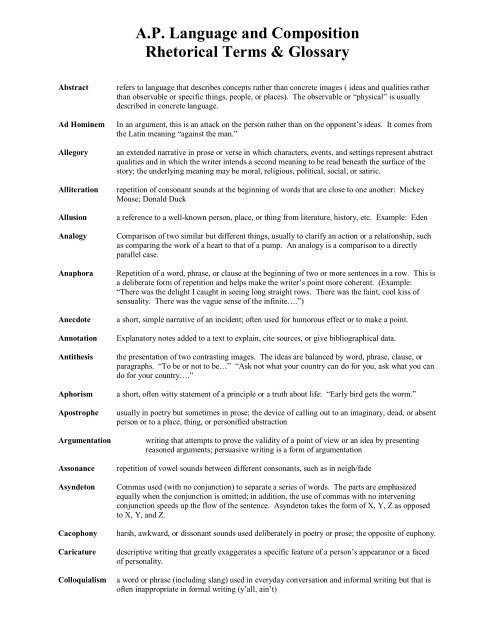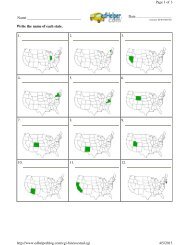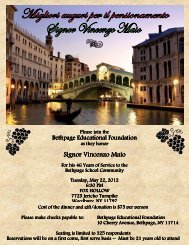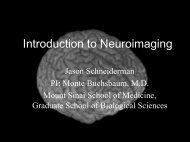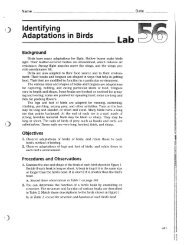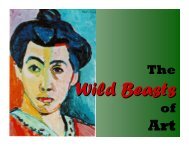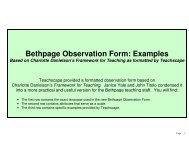AP Lang. Rhetorical Terms
AP Lang. Rhetorical Terms
AP Lang. Rhetorical Terms
Create successful ePaper yourself
Turn your PDF publications into a flip-book with our unique Google optimized e-Paper software.
A.P. <strong>Lang</strong>uage and Composition<strong>Rhetorical</strong> <strong>Terms</strong> & GlossaryAbstractAd HominemAllegoryAlliterationAllusionAnalogyAnaphoraAnecdoteAnnotationAntithesisAphorismApostropheArgumentationAssonanceAsyndetonCacophonyCaricatureColloquialismrefers to language that describes concepts rather than concrete images ( ideas and qualities ratherthan observable or specific things, people, or places). The observable or “physical” is usuallydescribed in concrete language.In an argument, this is an attack on the person rather than on the opponent’s ideas. It comes fromthe Latin meaning “against the man.”an extended narrative in prose or verse in which characters, events, and settings represent abstractqualities and in which the writer intends a second meaning to be read beneath the surface of thestory; the underlying meaning may be moral, religious, political, social, or satiric.repetition of consonant sounds at the beginning of words that are close to one another: MickeyMouse; Donald Ducka reference to a well-known person, place, or thing from literature, history, etc. Example: EdenComparison of two similar but different things, usually to clarify an action or a relationship, suchas comparing the work of a heart to that of a pump. An analogy is a comparison to a directlyparallel case.Repetition of a word, phrase, or clause at the beginning of two or more sentences in a row. This isa deliberate form of repetition and helps make the writer’s point more coherent. (Example:“There was the delight I caught in seeing long straight rows. There was the faint, cool kiss ofsensuality. There was the vague sense of the infinite….”)a short, simple narrative of an incident; often used for humorous effect or to make a point.Explanatory notes added to a text to explain, cite sources, or give bibliographical data.the presentation of two contrasting images. The ideas are balanced by word, phrase, clause, orparagraphs. “To be or not to be…” “Ask not what your country can do for you, ask what you cando for your country….”a short, often witty statement of a principle or a truth about life: “Early bird gets the worm.”usually in poetry but sometimes in prose; the device of calling out to an imaginary, dead, or absentperson or to a place, thing, or personified abstractionwriting that attempts to prove the validity of a point of view or an idea by presentingreasoned arguments; persuasive writing is a form of argumentationrepetition of vowel sounds between different consonants, such as in neigh/fadeCommas used (with no conjunction) to separate a series of words. The parts are emphasizedequally when the conjunction is omitted; in addition, the use of commas with no interveningconjunction speeds up the flow of the sentence. Asyndeton takes the form of X, Y, Z as opposedto X, Y, and Z.harsh, awkward, or dissonant sounds used deliberately in poetry or prose; the opposite of euphony.descriptive writing that greatly exaggerates a specific feature of a person’s appearance or a facedof personality.a word or phrase (including slang) used in everyday conversation and informal writing but that isoften inappropriate in formal writing (y’all, ain’t)
Extended MetaphorFalse AnalogyFigurative <strong>Lang</strong>uageFigures of SpeechForeshadowingFreight-TrainGeneralizationa sustained comparison, often referred to as a conceit. The extended metaphor isdeveloped throughout a piece of writingWhen two cases are not sufficiently parallel to lead readers to accept a claim ofconnection between them.language that contains figures of speech, such as similes and metaphors, in orderto create associations that are imaginative rather than literal.expressions, such as similes, metaphors, and personifications, that make imaginative,rather than literal, comparisons or associations.the use of a hint or clue to suggest a larger event that occurs late in the workSentence consisting of three or more very short independent clauses joined byconjunctions.When a writer bases a claim upon an isolated example or asserts that a claim is certainrather than probable. Sweeping generalizations occur when a writer asserts that a claimapplies to all instances instead of some.GenreHubrisHumorHyperboleImageImageryInductionInferencea type of literary work, such as a novel or poem; there are also subgenres, such as science fictionor sonnet, within the larger genresthe excessive pride of ambition that leads a tragic hero to disregard warnings of impending doom,eventually causing his or her downfall.anything that causes laughter or amusement; up until the end of the Renaissance, humor meant aperson’s temperamentdeliberate exaggeration in order to create humor or emphasis (Example: He was so hungry hecould have eaten a horse.)A word or words, either figurative or literal, used to describe a sensory experience or an objectperceived by the sense. An image is always a concrete representation.words or phrases that use a collection of images to appeal to one or more of the five senses inorder to create a mental picturethe process that moves from a given series of specifics to a generalizationa conclusion one can draw from the presented detailsInterior Monologuewriting that records the conversation that occurs inside a character’s headInvectiveInversionIronyJargonLogica verbally abusive attackreversing the customary (subject first, then verb, then complement) order of elements in a sentenceor phrase; it is used effectively in many cases, such as posing a question: “Are you going to thestore?” Usually, the element that appears first is emphasized more than the subject.a situation or statement in which the actual outcome or meaning is opposite to what was expected.The special language of a profession or group. The term jargon usually has pejorativeassociations, with the implication that jargon is evasive, tedious, and unintelligible to outsiders.The writings of the lawyer and the literary critic are both susceptible to jargon.the process of reasoningLogical Fallacy a mistake in reasoningLyricalSonglike; characterized by emotions, subjectivity, and imagination.
MetaphorMetonymyModeMoodMoralMotifNarrationa figure of speech in which one thing is referred to as another; for example, “my love is a fragileflower”a figure of speech that uses the name of an object, person, or idea to represent something withwhich it is associated, such as using “the crown” to refer to a monarch ; Also, “The pen is mightierthan the sword.”the method or form of a literary work; the manner in which a work of literature is writtensimilar to tone, mood is the primary emotional attitude of a work (the feeling of the work; theatmosphere). Syntax is also a determiner of mood because sentence strength, length, andcomplexity affect pacing.The lesson drawn from a fictional or nonfictional story. It can also mean a heavily didactic story.main theme or subject of a work that is elaborated on in the development of the piece; a repeatedpattern or ideathe telling of a story in fiction, nonfiction, poetry, or drama; one of the four modes of discourseNegative-PositiveSentence that begins by stating what is NOT true, then ending by stating what is true.Non-sequiturObjectivityLatin for “it does not follow.” When one statement isn’t logically connected to anotheran impersonal presentation of events and characters. It is a writer’s attempt to remove himself orherself from any subjective, personal involvement in a story. Hard news journalism is frequentlyprized for its objectivity, although even fictional stories can be told without a writer renderingpersonal judgment.Onomatopoeia the use of words that sound like what they mean, such as “hiss,” “buzz,” “slam,” and “boom”OversimplificationWhen a writer obscures or denies the complexity of the issues in an argumentOxymoronPacingParableParadoxParallelisma figure of speech composed of contradictory words or phrases, such as “wise fool,” bitter-sweet,”“pretty ugly,” “jumbo shrimp,” “cold fire”the movement of a literary piece from one point or one section to anothera short tale that teaches a moral; similar to but shorter than an allegorya statement that seems to contradict itself but that turns out to have a rational meaning, as in thisquotation from Henry David Thoreau; “I never found the companion that was so companionableas solitude.”the technique of arranging words, phrases, clauses, or larger structures by placing them side byside and making them similar in form. Parallel structure may be as simple as listing two or threemodifiers in a row to describe the same noun or verb; it may take the form of two or more of thesame type of phrases (prepositional, participial, gerund, appositive) that modify the same noun orverb; it may also take the form of two or more subordinate clauses that modify the same noun orverb. Or, parallel structure may be a complex bend of singe-word, phrase, and clause parallelismall in the same sentence.Example (from Churchill): “We shall fight on the beaches, we shall fight on the landing grounds,we shall fight in the fields.”ParodyPathosa work that ridicules the style of another work by imitating and exaggerating its elements. . It canbe utterly mocking or gently humorous. It depends on allusion and exaggerates and distorts theoriginal style and content.the aspects of a literary work that elicit sorrow or pity from the audience. An appeal to emotionthat can be used as a means to persuade. Over-emotionalism can be the result of an excess ofpathos.
Pedantica term used to describe writing that borders on lecturing. It is scholarly and academic and oftenoverly difficult and distantPersonification the attribution of human qualities to a nonhuman or an inanimate objectPersuasionPoint of Viewa form of argumentation, one of the four modes of discourse; language intended to convincethrough appeals to reason or emotion.the perspective from which a story is presented; common points of view include the following:First person narratora narrator, referred to as “I,” who is a character in the story and relatesthe actions through his or her own perspective, also revealing his or herown thoughtsStream of Consciousness like a first person narrator, but instead placing the reader inside thecharacter’s head, making the reader privy to the continuous, chaoticflow of disconnected, half-formed thoughts and impressions in thecharacter’s mindOmniscientLimited Omniscientthird person narrator, referred to as “he,” “she,” or “they,” who is ableto see into each character’s mind and understands all the actiona third person narrator who reports the thoughts of only one characterand generally only what that one character seesPolysyndetonProtagonistObjectivea third person narrator who only reports what would be visible to acamera; thoughts and feelings are only revealed if a character speaks ofthemSentence which uses and or another conjunction (with no commas) to separate the items in aseries. Polysyndeton appear in the form of X and Y and Z, stressing equally each member of aseries. It makes the sentence slower and the items more emphatic than in the asyndeton.the main character of a literary workRed HerringWhen a writer raises an irrelevant issue to draw attention away from the real issueReductio ad Absurdum the Latin for “to reduce to the absurd.” This is a technique useful in creating a comiceffect and is also an argumentative technique. It is considered a rhetorical fallacybecause it reduces an argument to an either/or choiceRegionalismRepetitionRhetorican element in literature that conveys a realistic portrayal of a specific geographical locale, usingthe locale and its influences as a major part of the plotWord or phrase used two or more times in close proximitythe art of effective communication, especially persuasive discourse; Rhetoric focuses on theinterrelationship of invention, arrangement, and style in order to create felicitous and appropriatediscourse.<strong>Rhetorical</strong> modes<strong>Rhetorical</strong> Questionexposition, description, narration, argumentationone that does not expect an explicit answer. It is used to pose an idea to be considered bythe speaker or audience.SarcasmSatireSettingSimileharsh, caustic personal remarks to or about someone; less subtle than ironyA work that reveals a critical attitude toward some element of human behavior by portraying it inan extreme way. Satire doesn’t simply abuse (as in invective) or get personal (as in sarcasm).Satire targets groups or large concepts rather than individuals.Time and place of a literary worka figure of speech that uses like, as, or as if to make a direct comparison between two essentiallydifferent objects, actions, or qualities; for example, “The sky looked like an artist’s canvas.”
SpeakerStereotypeStraw ManStyleSubjectivitySyllogismSymbolismSynecdochethe voice of a work; an author may speak as himself or herself or as a fictitious personaa character who represents a trait that is usually attributed to a particular social or racial group andwho lacks individuality; a conventional patter, expression or idea.When a writer argues against a claim that nobody actually holds or is universally considered weak.Setting up a straw man diverts attention from the real issues.an author’s characteristic manner of expression – his or her diction, syntax, imagery, structure, andcontent all contribute to stylea personal presentation of evens and characters, influenced by the author’s feelings and opinionsA form of reasoning in which two statements are made and a conclusion is drawn from them. Asyllogism is the format of a formal argument that consists of a major premise, a minor premise,and a conclusion. Example:Major Premise: All tragedies end unhappily.Minor Premise: Hamlet is a tragedy.Conclusion: Therefore, Hamlet ends unhappily.the use of symbols or anything that is meant to be taken both literally and as representative of ahigher and more complex significancea figure of speech in which a part of something is used to represent a whole, such as using“boards” to mean a stage or “wheels” to mean a car – or “All hands on deck.”Syntactic FluencySyntactic PermutationAbility to create a variety of sentence structures, appropriately complex and/or simpleand varied in length.Sentence structures that are extraordinarily complex and involved. They are oftendifficult for a reader to follow.SyntaxThemeThesisToneTransitionTricolonthe grammatical structure of a sentence; the arrangement of words in a sentence. Syntax includeslength of sentence, kinds of sentences (questions, exclamations, declarative sentences, rhetoricalquestions, simple, complex, or compound).the central idea or “message” or a literary workthe main idea of a piece of writing. It presents the author’s assertion or claim. The effectivenessof a presentation is often based on how well the writer presents, develops, and supports the thesis.the characteristic emotion or attitude of an author toward the characters, subject, and audience(anger, sarcastic, loving, didactic, emotional, etc.)a word or phrase that links one idea to the next and carries the reader from sentence to sentence,paragraph to paragraph.Sentence consisting of three parts of equal importance and length, usually three independentclauses.Understatement the opposite of exaggeration. It is a technique for developing irony and/or humor where onewrites or says less than intended.UnityVoicequality of a piece of writing (also see coherence)refers to two different areas of writing. One refers to the relationship between a sentence’s subjectand verb (active and passive voice). The second refers to the total “sound” of a writer’s style.


